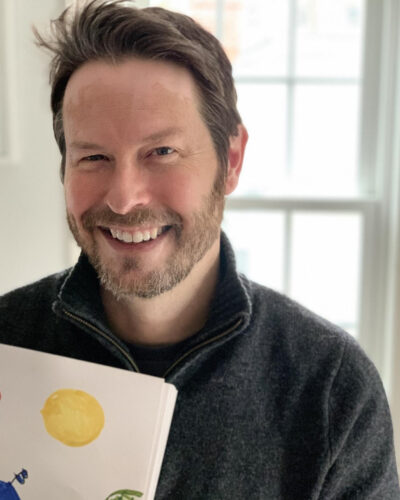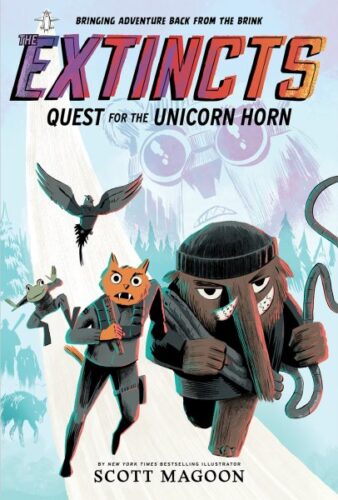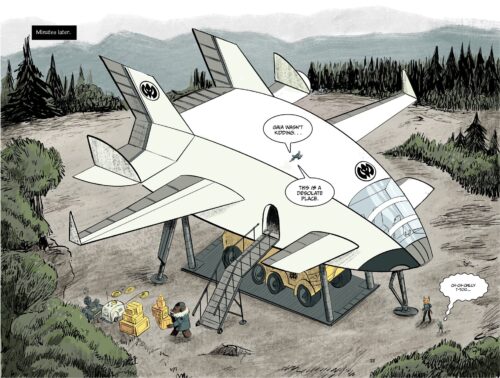Bringing Adventure Back From the Brink: A Scott Magoon Interview About The Extincts
I’m just sitting here, trying desperately to remember to remember the first Scott Magoon picture book I ever read. If his website is to be believed, he came on the scene with one of the finest the-protagonist-gets-eaten picture books of the modern era, Ugly Fish. Whatta debut! Over the years I then proceeded to read my kids books like The Luck of the Loch Ness Monster, Mostly Monsterly, and more. Was the transition to comics just a natural next step? Certainly folks like Vera Brosgol, Dan Santat, Lucy Knisley and others transition back and forth with ease. So I wasn’t too shocked when I encountered The Extincts (now on shelves everywhere!) in its final form. A description:
Meet Scratch, Martie, Lug, and Quito, members of a secret organization called R.O.A.R. When their boss, Dr. Z, finally calls on them for their first big mission, the team heads to Siberia to retrieve an ancient unicorn horn from the thawing permafrost. Scratch is thrilled at the chance to prove his worth to Dr. Z—but as soon as they land, the team runs into a mysterious enemy determined to take them down.
With exciting missions, plenty of humor, and an environmental angle, this series starter from New York Times bestselling illustrator Scott Magoon is an action-packed adventure from start to finish. The book will also include nonfiction back matter about extinct animals, climate change, and what kids can do to help!
Scott was kind enough to answer some of my burning questions on the subject.
Betsy Bird: Scott! What a delight to speak to you in some form again. And judging from the sheer amount of work that I can see went into THE EXTINCTS, I can see that you’ve been busy. Most of us are probably best familiar with your picture books. This, in contrast, is an intricately plotted, beautifully rendered graphic novel. Why the shift? And where did THE EXTINCTS come from?
ADVERTISEMENT
ADVERTISEMENT

Scott Magoon: Thank you for having me. I love sequential art and comics—read them forever, drew them for years, even before picture books. In fact I had a comic strip in college. Duct Tape Man wielded tape like Spider-Man slings webs. Throw in a dash of Doonesburyesque-if-quaint-campus commentary and you get the gist. It was an eye-opening experience in ways (art and story on a deadline!) and my first paying gig as an artist. I’ve had my eye on doing a graphic novel ever since. At its heart, Extincts came from a desire to tell a story about a character who feels marginalized—but finds acceptance and meaning in the eyes of one person. In Extincts, that character is Scratch, the Sabertooth tiger. I was interested in the heartbreak of what happens when he is betrayed—and it all comes crashing down. How does one respond? How do we best move forward after our hearts are broken?
BB: And in the course of this story you’ve mixed in both fairly well known extinct animal characters (wooly mammoth, saber-tooth tiger, etc.) and some of the more obscure varieties (cave bears, megafaunal wolves, etc.). I notice you didn’t restrict yourself to animals extinct because of reasons other than humans. The extinct animals in this story cover a wide swath of Earth’s history. How did you decide which ones to choose?
SM: I love the irony of extinct creatures starring in climate change fiction. But which to feature? My decisions were based on a few things. One was building the visual look of the team. Archetypal team dynamics call for brawn (Mammoth), athlete (Sabertooth Tiger), brains (Poison Frog), sensitivity (Pigeon). In addition, the creatures must look good together in a range of sizes and shapes.
I also researched each creature’s extinct story. For years I found the Passenger Pigeon story fascinating. Flying across America in massive flocks that blotted out the sun, for years they were an abundant, delicious and cheap source of food for people. Within the span of a few decades the passenger pigeon was the first extinction directly caused and witnessed by humans. The last passenger pigeon—Martha (for whom Martie is named)— died in the Cincinnati Zoo in 1914. A compelling narrative could follow Martie as she learns and reacts to the outrageous fate of her species, especially if she befriends humans.

BB: I love backmatter and you’ve given us a slew of resources and additional facts about extinct animals. What kind of research did you do for this book? And did you run across any facts that surprised you?
SM: Some source findings were serendipitous—like the book on de-extinction I discovered in a Canadian ferry boat giftshop while in the early stages of Extincts development (what were the odds?). I was introduced to the permafrost megaslump—the Batagaika Pit—by Expedition Unknown, one of my son’s favorite television programs. I visited Hammond Castle with my family on my birthday—and I found it to be a perfect a location for the team headquarters. A variety of ingredients are thrown into my simmering story pot.
The most unusual facts are also the natural ones. Passenger pigeons fly at over 60 MPH. Mammoths often died of starvation because they ran out of new teeth to chew food. Poison frogs are poisonous because they eat toxic bugs (who eat poisonous plants). But most surprising were the climate change facts. How much the damage we’ve done and that it is probably irreversible. How little people know about it, want to talk about it or think about. It is absolutely alarming. The world is on fire. Like the saying goes—if you’re not angry you are not paying attention.
BB: Well, and near the end of the book you mention that this book was written “to raise awareness of climate change and species extinction.” Could you tell us a little bit about your own awareness, where it originated, and what you hope this book will do for kids today?
SM: Like many of us, dinosaurs were my introduction to the scientific concept of extinction. During story time, I remember my kindergarten teacher, Mrs. Kane, reading us a book about dinosaurs. The last spread had ghostly dinosaurs next to humans and modern houses. That evocative image stuck with me. I like it today because the ghosts of extinct creatures are really all around us. And the lessons they teach us too—like the rock band The Police once sang —“Hey mighty brontosaurus /Don’t you have a lesson for us/ You thought your rule would always last/There were no lessons in your past.”

In addition, as a child, I saw an episode of The Bloodhound Gang from the PBS show 3-2-1 Contact. As a young boy, I watched “The Case of the Dead Man’s Pigeon” and first learned about Passenger Pigeons going extinct. I hope my book sticks with young readers as much as that show stuck with me. I hope they learn new stories about extinction and are curious to learn even more.
BB: Just wanted to mention that you get 100 points for mentioning The Bloodhound Gang (“If you’ve got the crime, we’ve got the time”). So was there anything you wanted to include in the book and just couldn’t keep for some reason?
SM: I wish I had time to include the moral and ethical consequences of bringing an animal back from extinction. Both from a scientific angle as well as from the animal’s point of view. Hopefully this can be woven into a future story.
BB: Now the tough question: What’s your favorite extinct species and why?
ADVERTISEMENT
ADVERTISEMENT
SM: There are so many, sadly. In this case, I’d say Neanderthals. It blows my mind that there were at least two species of humanoid creatures walking the earth at one time. I wonder what would the world be like today if they were still around. What would their culture be like? Interestingly, some of their DNA lives on in some modern humans’ DNA—maybe even yours and mine.
BB: Absolutely. Neanderthals are endlessly fascinating, and for the very reasons you just said. Finally, is this book a standalone or is there a chance that we’ll be seeing an EXTINCTS 2 in the future?
SM: I am finishing book two now. It is about the team battling Western wildfires where they meet Smokejumpers and Hotshot Firefighters. In book two, another character takes center stage as he learns to forgive himself for tragic past mistakes. For three years these books have been a labor of love. From penning the scripts and non-fiction backmatter, to designing the characters and vehicles. All so much fun. And with your readers help, my hope is that the EXTINCTS will live on as they have more stories to share in their quest to save the world. In the meantime, I hope you enjoy meeting the team. Thanks for meeting with me, Betsy. Go EXTINCTS!
BB: GO EXTINCTS!
Whole swaths of thanks to Scott for taking the time to answer my questions today. Thanks too to Mary Marolla and the folks at Abrams for setting this up. THE EXTINCTS is on shelves everywhere now, so pick yourself up a copy today.
Filed under: Interviews
About Betsy Bird
Betsy Bird is currently the Collection Development Manager of the Evanston Public Library system and a former Materials Specialist for New York Public Library. She has served on Newbery, written for Horn Book, and has done other lovely little things that she'd love to tell you about but that she's sure you'd find more interesting to hear of in person. Her opinions are her own and do not reflect those of EPL, SLJ, or any of the other acronyms you might be able to name. Follow her on Twitter: @fuseeight.
ADVERTISEMENT
ADVERTISEMENT
SLJ Blog Network
One Star Review, Guess Who? (#202)
Exclusive: Giant Magical Otters Invade New Hex Vet Graphic Novel | News
Parsing Religion in Public Schools
Take Five: LGBTQIA+ Middle Grade Novels
ADVERTISEMENT







